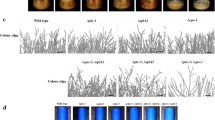Summary
Atwood'S method was used for scoring recessive lethals in aNeurospora heterokaryon with an amycelial component. Conidia were stored dry at 30° and 4°C, and samples were tested for lethals every few weeks over a period of 7 months. At 30°, lethals accumulated in strictly linear proportion with time, at a rate of 0.3% lethals per week. At 4°, the rate of accumulation was much slower; the data are not sufficient to decide whether it was linear. When conidia that had spent 24 weeks at 4° were transferred to 30°, the proportion of lethals increased steeply to the level that had meanwhile been reached in the warm series. This points to the possibility of resolving the mutational process into successive steps with different temperature coefficients. Reasons are given for presuming that none of the lethals had been present in the culture of origin and for excluding their occurrence through errors of gene replication during storage or on the plates.
When samples of conidia from the warm series were inserted into growth tubes, 80% or more of the accumulated lethals were lost during the initial stages of growth. Subsequently, lethals accumulated again at a rate that remained constant for at least 2 weeks. This, together with similar observations byAtwood andPittenger (1955), opens the possibility of studying mutation rates during growth in growth tubes.
Similar content being viewed by others
Literature
Atwood, K. C.: Detection of physiological mutants inNeurospora without the use of selective media. Biol. Bull.97, 254–255 (1949).
—: The homology patterns of induced lethal mutations inNeurospora crassa. Biol. Bull.99, 332 (1950).
—: Nuclear distribution in conidia ofNeurospora heterokaryons. Genetics40, 438–443 (1955).
Atwood, K. C., andF. Mukai: Indispensable gene functions inNeurospora. Proc. nat. Acad. Sci. (Wash.)39, 1027–1035 (1953).
Atwood, K. C., F. Mukai andT. H. Pittenger: “Punch tube” and “squirting” methods forNeurospora. Microbiol. Genet. Bull.16, 34–35 (1958).
Atwood, K. C., andT. Pittenger: X-ray-induced mutations in growing mycelium ofNeurospora. Radiat. Res.3, 212 (1955).
Bonnier, G., andU. B. Jonsson: Rate of development of viability mutants inDrosophila melanogaster. Evolution11, 271–279 (1957).
Byers, H. L., andH. J. Muller: Influence of ageing at two different temperatures on the spontaneous mutation rate in mature spermatozoa ofDrosophila melanogaster. Genetics37, 570–571 (1952).
Devi, P., G. Pontecorvo andC. H. Higginbottom: Mutations affecting the nutritional requirements ofAerobacter aerogenes induced by irradiation of dried cells. J. gen. Microbiol.5, 781–787 (1951).
Dobzhansky, Th., A. M. Holz andB. Spassky: Genetics of natural populations. VIII. Concealed variability in the second and fourth chromosomes ofDrosophila pseudo-obscura and its bearing on the problem of heterosis. Genetics27, 463–490 (1942).
Kaplan, R. W.: Spontane Mutabilität beiBacterium prodigiosum. Z. Naturforsch.2b, 308–312 (1947).
Lamy, R.: Observed spontaneous mutation rates in relation to experimental technique. J. Genet.48, 223–236 (1947).
Lieb, M.: Forward and reverse mutation in a histidine requiring strain ofEscherichia coli. Genetics36, 460–477 (1951).
Marcovich, H.: Recherches sur la mutabilité spontanée d'Escherichia coli B. Proc. X. Int. Congr. Genet.2, 179–180 (1958).
Meselson, M., andF. W. Stahl: The replication of DNA inEscherichia coli. Proc. nat. Acad. Sci. (Wash.)44, 671–682 (1958).
Muller, H. J.: Physiological effects on “spontaneous” mutation rate inDrosophila. Genetics31, 225 (1946).
The nature of the genetic effects produced by radiation. In: Radiation Biology, vol. I, pp. 351-473 (ed. A. Hollaender) New York: McGraw-Hill Book Comp. 1954.
Novick, A.: Mutagens and antimutagens. Brookhaven Symp. Biol.8, 201–216 (1955).
Novick, A., andL. Szilard: Experiments with the chemostat on spontaneous mutations of bacteria. Proc. nat. Acad. Sci. (Wash.)36, 708–719 (1950).
Ryan, F. J.: Spontaneous mutation in non-dividing bacteria. Genetics40, 726–738 (1955).
Ryan, F. J.: Mutation in non-dividing bacteria. Cytologia (Tokyo), Suppl., 555–558 (1957a).
—: Natural mutation in non-dividing bacteria. Trans. N.Y. Acad. Sci.19, 515–517 (1957b).
—: Mutation as an error in gene duplication. Proc. X. Int. Congr. Genet.2, 246 (1958).
Ryan, F. J., andL. K. Wainwright: Nuclear segregation and the growth of clones of spontaneous mutants of bacteria. J. gen. Microbiol.11, 364–379 (1954).
Scott, W. J.: Some interactions between factors affecting the viability of dried micro-organisms. J. gen. Microbiol.19, II-III (1958).
Taylor, H., P. S. Woods andW. L. Hughes: The organisation and duplication of chromosomes as revealed by autoradiographic studies using tritium-labelled thymidine. Proc. nat. Acad. Sci. (Wash.)43, 122–128 (1957).
Wainwright, L. K.: Spontaneous mutation in stored spores of a streptomyces species. J. gen. Microbiol.14, 533–544 (1956).
Watson, J. D., andF. H. C. Crick: Genetical implications of the structure of desoxyribonucleic acid. Nature (Lond.)171, 964–966 (1953).
Author information
Authors and Affiliations
Additional information
Operated by Union Carbide Corporation for the United States Atomic Energy Commission.
Work carried out while the author was a Visiting Investigator at Oak Ridge National Laboratory on leave of absence from Edinburgh University.
Rights and permissions
About this article
Cite this article
Auerbach, C. Spontaneous mutations in dry spores of Neurospora crassa. Zeitschrift für Vererbungslehre 90, 335–346 (1959). https://doi.org/10.1007/BF00888808
Received:
Issue Date:
DOI: https://doi.org/10.1007/BF00888808




